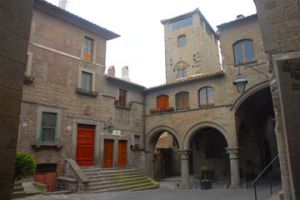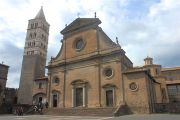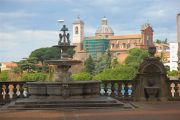 |
 |
Viterbo, a papal city |
 |
 |

|
 San Pellegrino / Viterbo © T. Joly San Pellegrino / Viterbo © T. Joly

|
Once a favourite residence of the Popes, Viterbo possesses numerous medieval monuments. Located in the heart of Etruria, this quiet town with an authentic atmosphere is a good base from which to explore the ancient Etruscan sites nearby.
[ Practical ]
- Getting there
By road
82 km from Rome on Via Cassia (roads SS2bis, SS2 and SP1) till Viterbo or 105 km on motorway A1 till Orte then on roads S204 and SS675 to Viterbo
By train
Train from Rome’s station Ostiense to Viterbo Porta Romana. Journey takes almost 2 hours.
By bus
Cotral buses run from Rome’s Saxa Rubra station (north of town, reached by urban railway from Flaminio). The journey takes bit more than one hour with direct buses.
- Lodging
Hotels
Hotel Belleti Palace
Best Western Hotel Viterbo
Hotel Mini Palace
Bed and Breakfast
Al Cardinale
La Terrazza Medioevale
San Pellegrino
- Restaurants
Al Vecchio Orologio
Caffé Schenardi
La Zaffera
- Going around
Cotral buses serve the towns and villages surrounding Viterbo but it’s more convenient to have a car to visit the Etruscan sites.
- Information
Viterbo Tourism Office (Azienda di Promozione Turistica della Provincia di Viterbo)
, by the Porta Romana railway station. Tel : 0761 291000/ 0761 304795
www.infoviterbo.it
Less than one hundred km north of Rome, far away from the flow of tourists that invade the Eternal City all year round, Viterbo offers a more authentic face of Italy. This bit sleepy town also possesses many monuments which are worth a detour and they can easily be discovered by foot in one day.
 Favourite residence of the Popes Favourite residence of the Popes
In the middle ages it was in fact one of the most important and powerful cities of the country. At that time it had 60 000 inhabitants, more than Rome and almost as many as today. A powerful past recalled by the huge walls surrounding the historical centre. 10 m high, they are made of blocks of dark volcanic stone giving them a threatening look when the weather is cloudy. The heyday of Viterbo dates back to the 13th century when it became the favourite residence of the Popes to whom it owes its most beautiful buildings. In particular their Gothic palace which has an elegant loggia, once covered, now an open space with a fountain in its centre. An excellent viewpoint to get a right idea of the length of the ramparts and of the topography of the city spread over several hills. Just beside stands the Cathedral of San Lorenzo, a Romanesque building on which was added a Renaissance façade and Gothic bell tower with white and black stones similar to the ones in Sienna.

 San Lorenzo Cathedral © T.Joly San Lorenzo Cathedral © T.Joly
|
 The longest conclave of history The longest conclave of history
Inside two tombs commemorate Popes Alexander IV and Clement IV who died in Viterbo in 1261 and 1268. At that time the papal election had to be held in the place where the previous Pope died and the city is famous for having hosted the longest conclave of history. More than two years and nine months !!! This despite the fact that after one and half year of vain talks, to try to speed up the process the authorities of Viterbo had decided to enclose the cardinals by lock and key. Cum clave in Latin which is the origin of the word conclave. A reaction which is more understandable when one knows that the inhabitants had to feed the Holy College for free during the deliberations. Then in 1281, the people didn’t accept the election of a foreign Pope, the French Martin IV who planned to go and live in Avignon. So they took two cardinals hostages to express their unhappiness. Not a good idea. The city was excommunicated and the Popes moved away putting an end to its prosperity. An historical event that is today a blessing for the tourists as the city, running out of money, wasn’t modernised for a while.
 Medieval quarter Medieval quarter
Thus, the San Pellegrino neighbourhood looks now as it did in the 13th century. A maze of sinuous streets, little squares, alleys, lanes, covered passageways, towers and stone houses with outside staircases. The whole makes for one of the world’s best preserved medieval quarters where numerous films have been shot. No need to say that a stroll in this part of the city is like stepping back into the past. And to extend this feeling it’s possible to spend the night there as some houses offer bed and breakfast accommodation. No far from there, the Pianoscarano neighbourhood is only slightly more recent.
However, after an absence of almost a century, Popes began to come back to Viterbo. Mainly in the summer time as the climate is cooler and more enjoyable than in Rome. On the contrary winters can be cold and even chilly when the wind blows. All around town the coats of arms of numerous Popes and cardinals remind us of their visits and the works they financed. The opening of new streets, the erection or restoration of buildings such as the Porta Romana, the nicest gateway of the walled city.

 Pallazo dei Priori © T.Joly Pallazo dei Priori © T.Joly
|
 Numerous fountains Numerous fountains
Another particularity of Viterbo is its large number of fountains. Standing in the middle of public squares or hidden in convents and palaces courtyards, there are 99 of them in all styles and from all periods. On Piazza del Sacrario the most recent one was done in 1966 and consists of two giant wings showered by a jet of water. Built in the 13th century with a spindle shape and adorned with lion heads spouting water, the Fontana Grande on via Cavour is considered the most beautiful. It’s also worth seeing the one in the garden of the Priori Palace that also houses a 17th century chapel and a room bearing superb 16th century frescoes depicting the legendary and real history of Viterbo. It has been the seat of the civil authorities in Viterbo since time immemorial along with the nearby Podesta Palace that is topped by a clock tower. All that said, as very often in Italy, a large part of the city’s architectural heritage is made up of churches, sometimes very ancient ones.
 Etruscan and Roman works Etruscan and Roman works
Of Romanesque style with Lombard influences, Santa Maria Nova dates back to the 11th century and hosts a wealth of frescoes from the 14th to the 16th century. Slightly more recent, San Silvestro is decorated with superb 15th century frescoes and was the scene of the murder of Henry of Cornwall in 1271. And if that’s not enough for art lovers there are still some museums to visit. Next door to the cathedral, the Museo del Colle del Duomo is dedicated to religious art and presents precious reliquaries. Housed in the former Rocca Alboroz fortress the Museo Nazionale exhibits antique statues and architectural elements. As for the Museo Civico it displays Roman and Etruscan works as well as a curiosity: fake antiquities created in the 15th century by Annius of Viterbo, a monk and forger who attempted to create fictitious histories for the town.
Nevertheless, to make the most of a stay in Viterbo it’s necessary to take the time to wander around the streets and explore the markets as well as the shops selling traditional products and antiques.
 Enjoy the Italian way of life Enjoy the Italian way of life
This is the opportunity to experience and enjoy the Italian way of life, the gastronomy and the local wines. Restaurants and ice cream shops are not in short supply but one place is not to be missed: the Caffé Schenardi, a restaurant–tea room dating back to the early 18th century housed in a 15th century palace. So, if a day is enough to see the best the town has to offer it’s also possible to spend a whole weekend or even longer here. Especially as the surroundings are dotted with interesting sites. On the outskirts of Viterbo is a very beautiful Renaissance church, Santa Maria della Quercai, as well as the Spa of the Popes installed by the Bullicame hot spring quoted by Dante in his “Inferno”. A perfect spot to relax after a day of visits. As is a stroll in the charming village of Bagnia where the Villa Lante houses one of the most marvellous example of Italian style Renaissance gardens. In addition to all this, famous and lesser known Etruscan sites such as Tarquinia, Norchia or Vulci are not far away.
September 08, 2015
Pascal Lefeuvre 

|
|
 |

|
 |



